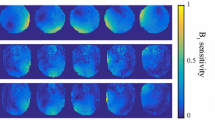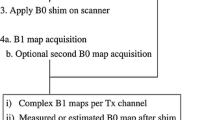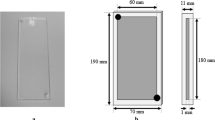Abstract
Introduction
The need for a homogeneous magnetic field in magnetic resonance imaging is well established, especially at high static magnetic field strengths where susceptibility-induced image distortions and signal losses become excessively large. Dynamic shim updating, where the optimal set of shim currents is applied for each slice during a multi-slice acquisition, has been shown to improve magnetic field homogeneity to a greater extent than conventional global shimming.
Methods
Here, in an initial feasibility study, we show via simulation that improved efficacy of shimming can be achieved by using the novel parcellated dynamic shimming method.
Results
The results of these simulations indicate that parcellated dynamic shimming based on just linear shim terms can perform approximately as well as slice-based dynamic shimming with up to third-order shim terms.
Conclusions
This work shows that the effective magnetic field inhomogeneity can be further reduced if shimming and image data acquisition are sequentially performed over a series of compact, cuboidal sub-volumes rather than planes. Further work is needed to develop an imaging approach that can be used for the optimal implementation of parcellated dynamic shimming.
Similar content being viewed by others
References
Li S, Dardzinski BJ, Collins CM, Yang QX, Smith MB (1996) Three-dimensional mapping of the static magnetic field inside the human head. Magn Reson Med 36(5): 705–714
Sumanaweera TS, Glover GH, Binford TO, Adler JR (1993) MR susceptibility misregistration correction. IEEE Trans Med Imaging 12: 251–259
Deichmann R, Josephs O, Hutton C, Corfield DR, Turner R (2002) Compensation of susceptibility-induced BOLD sensitivity losses in echo-planar fMRI imaging. Neuroimage 15(1): 120–135
Farahani K, Sinha U, Sinha S, Chiu LC-L, Lufkin RB (1990) Effect of field strength on susceptibility artifacts in magnetic resonance imaging. Comput Med Imaging Graph 14(6): 409–413
Roméo F, Hoult DI (1984) Magnet field profiling: analysis and correcting coil design. Magn Reson Med 1(1): 44–65
Conover W (1984) Practical guide to shimming superconducting NMR magnets, Chap 2. Wiley, New York, pp 37–41
Chmurny GN, Hoult DI (1990) The ancient and honourable art of shimming. Concepts Magn Reson 2(3): 131–149
Tochtrop M, Vollmann W, Holz D, Leussler C (1987) Automatic shimming of selected volumes in patients. Proc Soc Magn Reson Med 6: 816
Holz D, Jensen D, Proksa R, Tochtrop M, Vollmann W (1988) Automatic shimming for localized spectroscopy. Med Phys 15(6): 898–903
Press WH, Flannery BP, Teukolsky SA, Vetterling WT (1992) Numerical recipes in C: the art of scientific computing. Cambridge University Press, Cambridge
Prammer MG, Haselgrove JC, Shinnar M, Leigh JS (1988) A new approach to automatic shimming. J Magn Reson 77: 40–52
Gruetter R, Boesch C (1992) Fast, noniterative shimming of spatially localized signals. In vivo analysis of the magnetic field along axes. J Magn Reson 96: 323–334
Gruetter R (1993) Automatic, localized in vivo adjustment of all first- and second-order shim coils. Magn Reson Med 29(6): 804–811
Klassen LM, Menon RS (2004) Robust automated shimming technique using arbitrary mapping acquisition parameters (RASTAMAP). Magn Reson Med 51(5): 881–887
Frahm J, Merboldt KD, Hänicke W (1988) Direct FLASH MR imaging of magnetic field inhomogeneities by gradient compensation. Magn Reson Med 6(4): 474–480
Yang QW, Dardzinski BJ, Li S, Eslinger PJ, Smith MB (1997) Multi-gradient echo with susceptibility inhomogeneity compensation (MGESIC): demonstration of fMRI in the olfactory cortex at 3.0T. Magn Reson Med 37(3): 331–335
Cho ZH, Ro YM (1992) Reduction of susceptibility artefact in gradient-echo imaging. Magn Reson Med 23(1): 193–200
Chen N-K, Wyrwicz AM (1999) Removal of intravoxel dephasing artifact in gradient echo images using a field-map based RF refocussing technique. Magn Reson Med 42(2): 807–812
Stenger VA, Boada FE, Noll DC (2000) Three dimensional tailored rf pulses for the reduction of susceptibility atrifacts in T2*-weighted functional MRI. Magn Reson Med 44(4): 525–531
Schneider E, Glover G (1991) Rapid in vivo proton shimming. Magn Reson Med 18: 335–347
Wilson JL, Jenkinson M, Araujo I, Kringelbach ML, Rolls ET, Jezzard P (2002) Fast, fully automated global and local magnetic field optimization for fMRI of the human brain. Neuroimage 17: 967–976
Blamire AM, Rothman DL, Nixon T (1996) Dynamic shim updating: a new approach towards optimized whole brain shimming. Magn Reson Med 36(1): 159–165
Morrell G, Spielman D (1997) Dynamic shimming for multi-slice magnetic resonance imaging. Magn Reson Med 38(3): 477–483
Graaf RA, Brown PB, McIntyre S, Rothman DL, Nixon TW (2003) Dynamic shim updating (DSU) for multislice signal acquisition. Magn Reson Med 49(3): 409–416
Poole M, Bowtell R (2007) Evaluation of parcellated dynamic shimming. ISMRM workshop on advances in high field MR, 5
Saad N, Peled S (2005) Easy 3D phase unwrapping. Proc Int Soc Magn Reson Med 13: 2251
Smith SM (2002) Fast, robust automated brain extraction. Human Brain Map 17: 143–155
Koch KM, McIntyre S, Nixon TW, Rothman DL, Graaf RA (2006) Dynamic shim updating on the human brain. J Magn Reson 180(2): 286–296
Wen H, Jaffer FA (1995) An in vivo automated shimming method taking into account shim current constraints. Magn Reson Med 34(6): 898–904
Coleman TF, Li YY (1996) An interior trust region approach for nonlinear minimization subject to bounds. SIAM J Optim 6(2): 418–445
Poole M, Bowtell R (2007) Novel gradient coils designed with a boundary element method. Concepts Magn Reson B Magn Reson Eng 31(3): 162–175
Pissanetzky S (1992) Minimum energy MRI gradient coils of general geometry. Meas Sci Technol 3(7): 667–673
Lemdiasov RA, Ludwig R (2005) A stream function method for gradient coil design. Concepts Magn Reson B Magn Reson Eng 26(1): 67–80
Mansfield P, Howseman AM, Ordidge RJ (1989) Volumar imaging using NMR spin echoes: echo-volumar imaging (EVI) at 0.1 t. J Phys E 22(5): 324–330
Singh S, Rutt BK, Henkelman RM (1990) Projection presaturation: a fast and accurate technique for multidimensional spatial localization. J Magn Reson 87(3): 567–583
Zwaag W, Francis S, Bowtell RW (2006) Improved echo volumar imaging (EVI) for functional MRI. Magn Reson Med 56(6): 1320–1327
Pauly JM, Hu BS, Wang SJ, Nishimura DG, Macovski A (1993) A three-dimensional spin-echo or inversion pulse. Magn Reson Med 29(1): 2–6
Stenger VA, Boada FE, Noll DC (2000) Three-dimensional tailored RF pulses for the reduction of susceptibility artifacts in t2-weighted functional MRI. Magn Reson Med 44(4): 525–531
Stenger VA, Boada FE, Noll DC (2003) Variable-density spiral 3D tailored RF pulses. Magn Reson Med 50(5): 1100–1106
Bottomley PA, Hardy CJ (1987) Two-dimensional spatially selective spin inversion and spin-echo refocusing with a single nuclear magnetic resonance pulse. J Appl Phys 62(10): 4284–4290
Katscher U, Bornert P, Leussler C, Brink JS (2003) Transmit SENSE. Magn Reson Med 49(1): 144–150
Preussmann KP, Weiger M, Scheidegger MB, Boesiger P (1999) SENSE: sensitivity encoding for fast MRI. Magn Reson Med 42: 952–962
Berger MJ, Colella P (1989) Local adaptive mesh refinement for shock hydrodynamics. J Comput Phys 82(1): 64–84
Xu W, Cumming I (1999) A region-growing algorithm for InSAR phase unwrapping. IEEE Trans Geosci Remote Sens 37: 124–134
Author information
Authors and Affiliations
Corresponding author
Rights and permissions
About this article
Cite this article
Poole, M., Bowtell, R. Volume parcellation for improved dynamic shimming. Magn Reson Mater Phy 21, 31 (2008). https://doi.org/10.1007/s10334-007-0102-2
Received:
Revised:
Accepted:
Published:
DOI: https://doi.org/10.1007/s10334-007-0102-2




